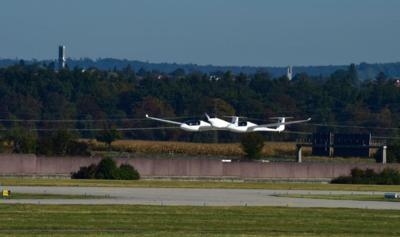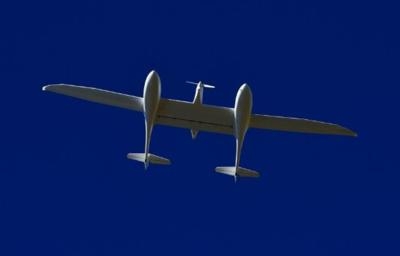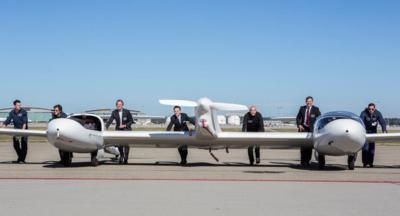Aircraft The Result Of A Collaboration Between DLR, Pipistrel, The University Of Ulm, Others
The HY4 aircraft took off on its first official flight from Stuttgart Airport on Thursday. The HY4 is the world’s first four-seat passenger aircraft powered solely by a hydrogen fuel cell system. Researchers from the German Aerospace Center (Deutsches Zentrum für Luft- und Raumfahrt; DLR) developed the aircraft's power train and worked on the project with industry and research partners.

The HY4 fuel cell aircraft was developed by the DLR Institute of Engineering Thermodynamics together with partners Hydrogenics, Pipistrel, H2FLY, the University of Ulm and Stuttgart Airport. DLR researchers were responsible for developing the hydrogen fuel cell power train and installing it in the aircraft. The power train consists of a hydrogen storage system, a low-temperature hydrogen fuel cell and a battery. The fuel cell converts hydrogen directly into electrical energy. The only waste product from this process is water. An electric motor uses the power thus generated to propel the aircraft. A high-performance lithium battery covers peak power loads during take-off and when climbing. If the hydrogen required for the fuel cell is generated via electrolysis using power from renewable energy sources, the HY4 can fly without generating any emissions at all. The aircraft is operated by the DLR spin-off H2FLY.

"I am proud that European researchers and manufacturers are launching this hydrogen fuel cell powered aircraft. Such forward looking activities embody the future of zero-emission flying," said Violeta Bulc, EU Transport Commissioner on Zero Emission Flying. "The Commission firmly supports such initiatives, which are fully in line with our new strategy for low-emission mobility. Aviation plays an important role in bringing people together, connecting large cities as well as remote locations. It also ensures businesses can grow and develop. The EU will continue to support such initiatives, to drive innovation forward. Georg Fundel, Managing Director of Flughafen Stuttgart GmbH, is delighted by the fact that the first flight took place at Stuttgart Airport: "Further growth is expected for Stuttgart Airport and aviation in general. For us, this is an important reason to focus on environment-friendly and, someday, even zero-emission aviation, as well as innovative technologies."
"For the foreseeable future, large passenger aircraft will continue to fly using conventional propulsion. One of the major challenges for the coming decades, however, is bringing electromobility to the aviation industry and making the air transport system of the future carbon dioxide neutral," said André Thess, Head of the DLR Institute of Engineering Thermodynamics. "Our goal is to further improve the fuel cell power train and, in the long term, use it on regional aircraft with up to 19 passengers." DLR is currently actively involved in electric aviation together with industry partners Airbus Group and Siemens, as well as 20 university institutes and Helmholtz centers as part of the Helmholtz Association's Electric Flight initiative.

The HY4 has a motor output of 80 kilowatts, a maximum speed of approximately 200 kilometres per hour (approx. 107 knots) and a cruising speed of 145 kilometres per hour (approx. 78 knots). Depending on speed, altitude and load, it can achieve a range of between 750 (approx. 405 nm) and 1500 kilometres (810 nm). The most striking feature of the HY4 is its twin fuselages, each with space for two passengers. The maximum weight of the aircraft is 1500 kilograms. "With the HY4, we now have an optimal platform to continue developing the use of fuel cells on aircraft," says Josef Kallo, responsible for the HY4 project at DLR and a Professor at the University of Ulm. "Small passenger aircraft, such as the HY4, could soon be used in regional transport as electric air taxis and offer a flexible and rapid alternative to existing means of transport."
(Images provided with DLR news release)
 ANN's Daily Aero-Term (04.26.24): DETRESFA (Distress Phrase)
ANN's Daily Aero-Term (04.26.24): DETRESFA (Distress Phrase) ANN's Daily Aero-Linx (04.26.24)
ANN's Daily Aero-Linx (04.26.24) Airborne 04.22.24: Rotor X Worsens, Airport Fees 4 FNB?, USMC Drone Pilot
Airborne 04.22.24: Rotor X Worsens, Airport Fees 4 FNB?, USMC Drone Pilot Airborne 04.24.24: INTEGRAL E, Elixir USA, M700 RVSM
Airborne 04.24.24: INTEGRAL E, Elixir USA, M700 RVSM Airborne-NextGen 04.23.24: UAVOS UVH 170, magni650 Engine, World eVTOL Directory
Airborne-NextGen 04.23.24: UAVOS UVH 170, magni650 Engine, World eVTOL Directory





